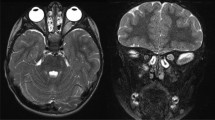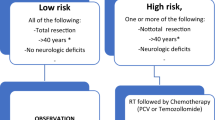Abstract
Purpose
Children with sporadic optic pathway glioma (OPG) commonly experience a decline in visual acuity (VA). This study aimed to quantify long-term VA outcomes after definitive radiation therapy (RT).
Methods
From 1997 to 2017, 41 patients underwent RT for OPG and had baseline VA testing. All patients underwent serial VA testing every 3–6 months during the first 5 years and annually thereafter. The cumulative incidence of VA decline or improvement (per eye) was estimated using death as a competing risk.
Results
Mean follow-up was 5 years. Most tumors (93%) involved the postchiasmatic optic tracts and/or hypothalamus. Of the tumors tested for BRAF alterations (n = 15), 67% had a BRAF fusion. Median time to VA decline was 20 months in the eye with worse vision and 22 months in the better eye. For the worse eye, the 5-year cumulative incidences of VA decline and improvement were 17.9% [95% confidence interval (CI) 7–32.8%] and 13.5% (95% CI 4.7–26.7%), respectively. For the better eye, the 5-year cumulative incidences of VA decline and improvement were 11.5% (95% CI 3.5–30.7%) and 10.6% (95% CI 2.6–25.2%), respectively. Visual outcomes did not correlate with radiographic evidence of tumor progression.
Conclusions
The 5-year cumulative incidence of VA decline was low. VA decline is most likely to occur within the first 2 years after RT and is not associated with radiographic progression of disease, highlighting the need for frequent ophthalmologic exams during this period.


Similar content being viewed by others
References
Binning MJ, Liu JK, Kestle JRW, Brockmeyer DL, Walker ML (2007) Optic pathway gliomas: a review. Neurosurg Focus 23(5):E2. https://doi.org/10.3171/FOC-07/11/E2
Pizzo PA, Poplack DG (eds) (2016) Principles and practice of pediatric oncology, 7th edn. Wolters Kluwer, Philadelphia
Trevisson E, Cassina M, Opocher E et al (2017) Natural history of optic pathway gliomas in a cohort of unselected patients affected by neurofibromatosis 1. J Neurooncol 134(2):279–287. https://doi.org/10.1007/s11060-017-2517-6
Campen CJ, Gutmann DH (2018) Optic pathway gliomas in neurofibromatosis type 1. J Child Neurol 33(1):73–81. https://doi.org/10.1177/0883073817739509
Tsang DS, Murphy ES, Merchant TE (2017) Radiation therapy for optic pathway and hypothalamic low-grade gliomas in children. Int J Radiat Oncol Biol Phys 99(3):642–651. https://doi.org/10.1016/j.ijrobp.2017.07.023
Falzon K, Drimtzias E, Picton S, Simmons I (2018) Visual outcomes after chemotherapy for optic pathway glioma in children with and without neurofibromatosis type 1: results of the International Society of Paediatric Oncology (SIOP) Low-Grade Glioma 2004 trial UK cohort. Br J Ophthalmol 102(10):1367–1371. https://doi.org/10.1136/bjophthalmol-2017-311305
Dodgshun AJ, Elder JE, Hansford JR, Sullivan MJ (2015) Long-term visual outcome after chemotherapy for optic pathway glioma in children: site and age are strongly predictive. Cancer 121(23):4190–4196. https://doi.org/10.1002/cncr.29649
Awdeh RM, Kiehna EN, Drewry RD et al (2012) Visual outcomes in pediatric optic pathway glioma after conformal radiation therapy. Int J Radiat Oncol Biol Phys 84(1):46–51. https://doi.org/10.1016/j.ijrobp.2011.10.067
Wan MJ, Ullrich NJ, Manley PE, Kieran MW, Goumnerova LC, Hiedary G (2016) Long-term visual outcomes of optic pathway gliomas in pediatric patients without neurofibromatosis type 1. J Neurooncol 129(1):173–178
Singhal S, Birch J, Kerr B, Lashford L, Evans D (2002) Neurofibromatosis type 1 and sporadic optic gliomas. Arch Dis Child 87(1):65–70. https://doi.org/10.1136/adc.87.1.65
Czyzyk E, Jóźwiak S, Roszkowski M, Schwartz RA (2003) Optic pathway gliomas in children with and without neurofibromatosis 1. J Child Neurol 18(7):471–478. https://doi.org/10.1177/08830738030180070401
Ashtrup J (2003) Natural history and clinical management of optic pathway glioma. Br J Neurosurg 17(4):327–335
Merchant TE, Conklin HM, Wu S, Lustig RH, Xiong X (2009) Late effects of conformal radiation therapy for pediatric patients with low-grade glioma: prospective evaluation of cognitive, endocrine, and hearing deficits. J Clin Oncol 27(22):3691–3697. https://doi.org/10.1200/JCO.2008.21.2738
Pierce SM, Barnes PD, Loeffler JS, McGinn C, Tarbell NJ (1990) Definitive radiation therapy in the management of symptomatic patients with optic glioma. Survival and long-term effects. Cancer 65(1):45–52
Grabenbauer GG, Schuchardt U, Buchfelder M et al (2000) Radiation therapy of optico-hypothalamic gliomas (OHG)—radiographic response, vision and late toxicity. Radiother Oncol 54(3):239–245
Dodge HW, Love JG, Craig WM et al (1958) Gliomas of the optic nerves. AMA Arch Neurol Psychiatry 79(6):607–621. https://doi.org/10.1001/archneurpsyc.1958.02340060003001
Liu GT, Volpe NJ, Galetta SL (eds) (2010) Neuro-ophthalmology: diagnosis and management, 2nd edn. Saunders, Philadelphia
The Pediatric Eye Disease Investigator Group (2002) A randomized trial of atropine vs. patching for treatment of moderate amblyopia in children. Arch Ophthalmol 120(3):268–278. https://doi.org/10.1001/archopht.120.3.268
Eisenhauer EA, Therasse P, Bogaerts J et al (2009) New response evaluation criteria in solid tumours: revised RECIST guideline (version 1.1). Eur J Cancer 45(2):228–247. https://doi.org/10.1016/j.ejca.2008.10.026
Capper D, Preusser M, Habel A et al (2011) Assessment of BRAF V600E mutation status by immunohistochemistry with a mutation-specific monoclonal antibody. Acta Neuropathol 122(1):11–19. https://doi.org/10.1007/s00401-011-0841-z
Capper D, Berghoff AS, Magerle M et al (2012) Immunohistochemical testing of BRAF V600E status in 1,120 tumor tissue samples of patients with brain metastases. Acta Neuropathol 123(2):223–233. https://doi.org/10.1007/s00401-011-0887-y
Qaddoumi I, Orisme W, Wen J et al (2016) Genetic alterations in uncommon low-grade neuroepithelial tumors: BRAF, FGFR1, and MYB mutations occur at high frequency and align with morphology. Acta Neuropathol 131(6):833–845. https://doi.org/10.1007/s00401-016-1539-z
Fine JP, Gray RJ (1999) A proportional hazards model for the subdistribution of a competing risk. J Am Stat Assoc 94(446):496–509. https://doi.org/10.2307/2670170
World Health Organization (2006) List of Official ICD-10 Updates Ratified, October 2006. Geneva. https://www.who.int/classifications/icd/2006Updates.pdf. Accessed 17 May 2019
Aquilina K, Daniels DJ, Spoudeas H, Phipps K, Gan H-W, Boop FA (2015) Optic pathway glioma in children: does visual deficit correlate with radiology in focal exophytic lesions? Childs Nerv Syst 31(11):2041–2049. https://doi.org/10.1007/s00381-015-2855-7
Kieran MW, Bouffet E, Tabori U et al (2016) CNS tumours. The first study of dabrafenib in pediatric patients with BRAF V600-mutant relapsed or refractory low-grade gliomas. Ann Oncol. https://doi.org/10.1093/annonc/mdw435.09
Fangusaro J, Onar-Thomas A, Poussaint TY et al (2019) Selumetinib in paediatric patients with BRAF-aberrant or neurofibromatosis type 1-associated recurrent, refractory, or progressive low-grade glioma: a multicentre, phase 2 trial. Lancet Oncol. https://doi.org/10.1016/S1470-2045(19)30277-3
Avery RA, Ferner RE, Listernick R, Fisher MJ, Gutmann DH, Liu GT (2012) Visual acuity in children with low grade gliomas of the visual pathway: implications for patient care and clinical research. J Neurooncol 110(1):1–7. https://doi.org/10.1007/s11060-012-0944-y
Avery RA, Cnaan A, Schuman JS et al (2015) Longitudinal change of circumpapillary retinal nerve fiber layer thickness in children with optic pathway gliomas. Am J Ophthalmol 160(5):944–952.e1. https://doi.org/10.1016/j.ajo.2015.07.036
Fisher MJ, Avery RA, Allen JC et al (2013) Functional outcome measures for NF1-associated optic pathway glioma clinical trials. Neurology 81(21 Suppl 1):S15–S24. https://doi.org/10.1212/01.wnl.0000435745.95155.b8
Acknowledgements
The authors thank Keith A. Laycock, PhD, ELS, for scientific editing of the manuscript and Tina D. Davis MBA, RHIA, Erin Kelly, MSW, and Samantha Buhler, CCRP, for assistance in data collection.
Funding
All authors receive research support from the American Lebanese Syrian Associated Charities (ALSAC).
Author information
Authors and Affiliations
Corresponding author
Ethics declarations
Conflict of interest
No conflicts of interest.
Additional information
Publisher's Note
Springer Nature remains neutral with regard to jurisdictional claims in published maps and institutional affiliations.
Electronic supplementary material
Below is the link to the electronic supplementary material.
Rights and permissions
About this article
Cite this article
Acharya, S., Quesada, S., Coca, K. et al. Long-term visual acuity outcomes after radiation therapy for sporadic optic pathway glioma. J Neurooncol 144, 603–610 (2019). https://doi.org/10.1007/s11060-019-03264-2
Received:
Accepted:
Published:
Issue Date:
DOI: https://doi.org/10.1007/s11060-019-03264-2




